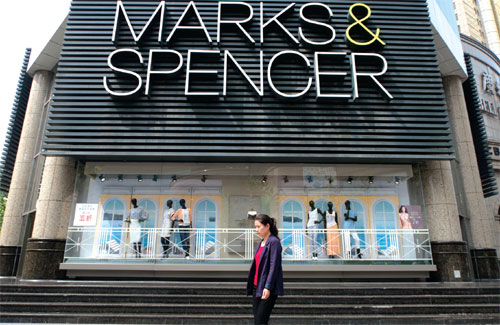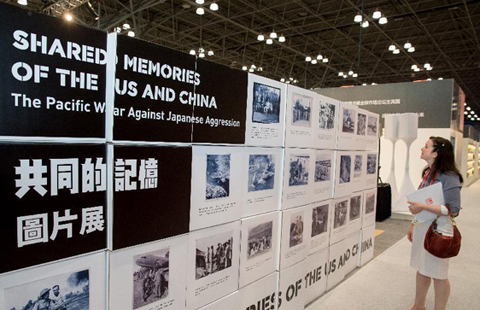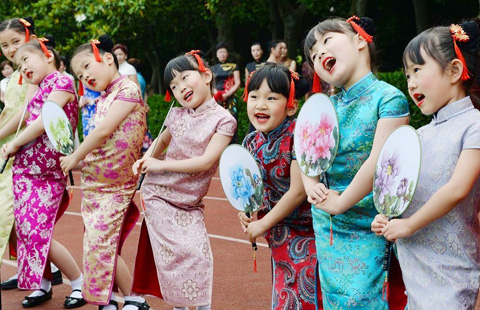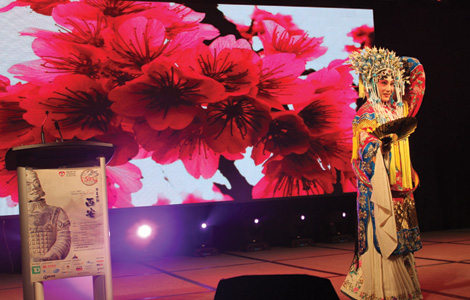Mind the gap
Updated: 2015-05-29 11:43
By Matt Hodges(China Daily USA)
|
||||||||
|
British retailer M&S is closing five stores in the Shanghai region. Photos by Gao Erqiang / China Daily |
"Our commercial plan is integrated, whether it's social, digital, omni-channel," said Barnes. "All the pieces should tie together."
Gap Inc recently reported that its first-quarter global net sales contracted 3 percent year-on-year to $3.66 billion - it did not explain why - but there is no doubt that Old Navy's global success led the conglomerate's fortunes last year.
The mother ship posted net sales of $16.44 in 2014, up 2 percent from 2013. Gap's sales were down 5 percent during that period. Old Navy's rose by the same margin.
In fact, one of the largest apparel brands in the US - Old Navy is bigger than Levi's, Adidas and Gap - will remember 2014 as one of its most successful years to date in its home market, where it has over 1,000 stores.
Now it must see if it can gain enough traction in China to carry Gap if the same happens here - after first enjoying a nice little piggy-back ride into the market.
"Brand awareness of international fast fashion brands has rapidly improved in China in recent years," said Regina Yang, director and head of research and consultancy at Knight Frank Shanghai.
"They have been successful because their small inventories and quick turnover allow them to quickly adapt to changing consumer demands.
Fast fashion sells because the brands offer lower prices, fashionable designs, immediately available trends, high product variety and a strong global image.
Even though media reports claim it takes H&M and Zara three months to get new product ideas into their stores - or 10 months in Gap's case - clothes can go from the catwalk to the shelf in as little as four weeks.
This clearly appeals to Chinese consumers, who are known to be more fashion-forward and bigger risk-takers than their American counterparts. Often, the younger generation leads the way.
"Though both Gap and Old Navy are considered lower-grade and inexpensive among American consumers, their product lines and price points are attractive to Chinese youth," said Chiang Jeongwen, a professor of marketing at CEIBS, China's top-ranked business school.
American guanxi
Old Navy's China business appears to be flourishing despite it willfully trampling over some of the golden rules for success here - it refuses to localize its products, for example - and at least some credit is due to Gap.
The twins are so tight they even share a head office in Shanghai. Gap arrived in the Middle Kingdom in 2010 and Old Navy, the self-styled king of "American edited fashion", came in March 2014. There is no reason to assume Banana Republic won't be joining them down the road.
Gap opened its 100th store in 2014 and reported brand awareness of over 70 percent in 2013. Whatever travails it has experience in China, Old Navy is unlikely to repeat any of its misfires.
"When I have a question, I'm not having to go to a competitor or try to figure out what they did. I can just walk right outside my office and say, 'What did you guys do?'" said Barnes.
Chinese society is built on networks of personal relationships known as guanxi, and this is American guanxi at its best.
"We can leverage like crazy and draw on Gap's expertise in terms of all the operational setups, the logistics setups, the real-estate knowledge and the infrastructure that is already built," he said. "This means we can use a really small team."
At their airy, sunlit office, a billboard for Old Navy's spring clothing campaign shows a group of friends in a jeep in the US. The quintessentially American theme is backed by the tag "Good Looks Ahead". All of its marketing campaigns are global.
"No, we're not going to do a China spring road trip," said Barnes. "The campaign is working great here." Even its best-selling products are the same in both countries. Go figure.
Old Navy began its international journey in 2001 in Canada and, later, Puerto Rico. It has been in Japan for almost three years, but its 40-plus stores there are likely to be dwarfed by the brand's presence in China before long.
Its sweet spot is that it caters to the whole family, something which distinguishes it from rivals like H&M and Japan's Uniqlo.
Media reports show China to be H&M's fastest-growing market and the source of 50 percent of Uniqlo's sales. Abercrombie & Fitch and Levis target a younger, more male demographic.
Missing the mark
But this refusal to change the game plan and bend to local tastes has proven a costly mistake for midscale retailer M&S, which has supplied generations of British kids with school uniforms. It entered China in 2008.
The brand, equally famous here for its imported food, had to recalibrate after making a litany of mistakes from day one. It now plans to close five of its supporting stores in tier-two cities in the Shanghai region.
It erred by focusing too much on Shanghai and trying to copy its Hong Kong road map, where it has successfully operated for two decades.
"When the first store in Shanghai opened, we saw that the clothing sizes were large and don't fit Chinese. M&S also admitted that it had misunderstood the local market," said Yang.
"The prices are high for the mainland and many of the garments look like they are designed for middle-aged people and old women," she added.
According to a spokeswoman for the brand's China operations, M&S will enter key cities such as Beijing and Guangzhou from 2015-16, where its growing e-commerce business shows it has strong brand awareness.
"For the long term, M&S is in the process of evaluating potential partners," the spokeswoman added.
Yet all three brands - M&S, Old Navy and Gap - are prospering from their baby and kidswear lines, partly because of the perceived safety of foreign garments in China. At one of Gap's stores next to an Apple flagship in Shanghai's Hong Kong plaza, its kidswear lines dominate most of the window displays.
Gap plans to add 25 to 30 stores in China this year, despite China's GDP slowing to 7 percent, the slowest in decades. Old Navy opened its latest in Wuhan, a wealthy city in Hubei province, a couple of weeks ago. It is exploring the opportunity to open another in Hangzhou, an affluent city in Zhejiang where Gap already has four stores.
Many fast-fashion brands and other mid-priced retailers are expected to continue entering and expanding in second-tier cities this year, Knight Frank reported.
"Traditional tier-two cities are rising and becoming the new tier-ones because of the strong purchasing power of their residents," said Mia Kuo, senior manager of communications for Gap Greater China.
"We don't want to build above our brand awareness," said Barnes. "We don't want to get into real estate that doesn't support our economic model. If we do those two things well, we will succeed."
Barnes, who was born in Las Vegas, oversaw Old Navy's successful move into Canada and seems the very embodiment of the lifestyle it promotes.
When China Daily first met the 46-year-old last summer, he was playing pool at an American-themed sports bar while his wife and daughters tucked into some fast food. The whole tableau was one of a wholesome American family.
For one store opening in Shanghai last August, he flew over a troupe of American cheerleaders. For its China launch, the brand brought over a marching band, a giant gumball machine and other pieces of Americana.
It was a very American script - and it totally worked. Somehow, Old Navy didn't have to change for China. China changed for it.
"It's that aspirational American thing," said Barnes, referring to the road trip campaign. "It appeals to everyone."
Contact the writer at matthewhodges@chinadaily.com.cn.
- Half of college students want to work in second-tier cities: Survey
- CPC publishes 'self-decoding' books for Western audience
- Capital aiming for 208 new care centers for the elderly
- Ten photos you don’t wanna miss – May 29
- Guangdong police bust huge 'ice' labs
- Patients take precedence for top researcher
Most Viewed
Editor's Picks

|

|

|

|

|

|
Today's Top News
China's most-wanted fugitive set to be extradited by US
US charges 15 Chinese nationals in college exam fraud scheme
Former US House Speaker Hastert indicted on federal charges
No one tells us what to do, Beijing says
Li: Spain a partner for new market
Foreign policy not foreign: expert
China makes splash at book fair
Brazil ready to collaborate over FIFA graft probe
US Weekly

|

|
















